Paper Menu >>
Journal Menu >>
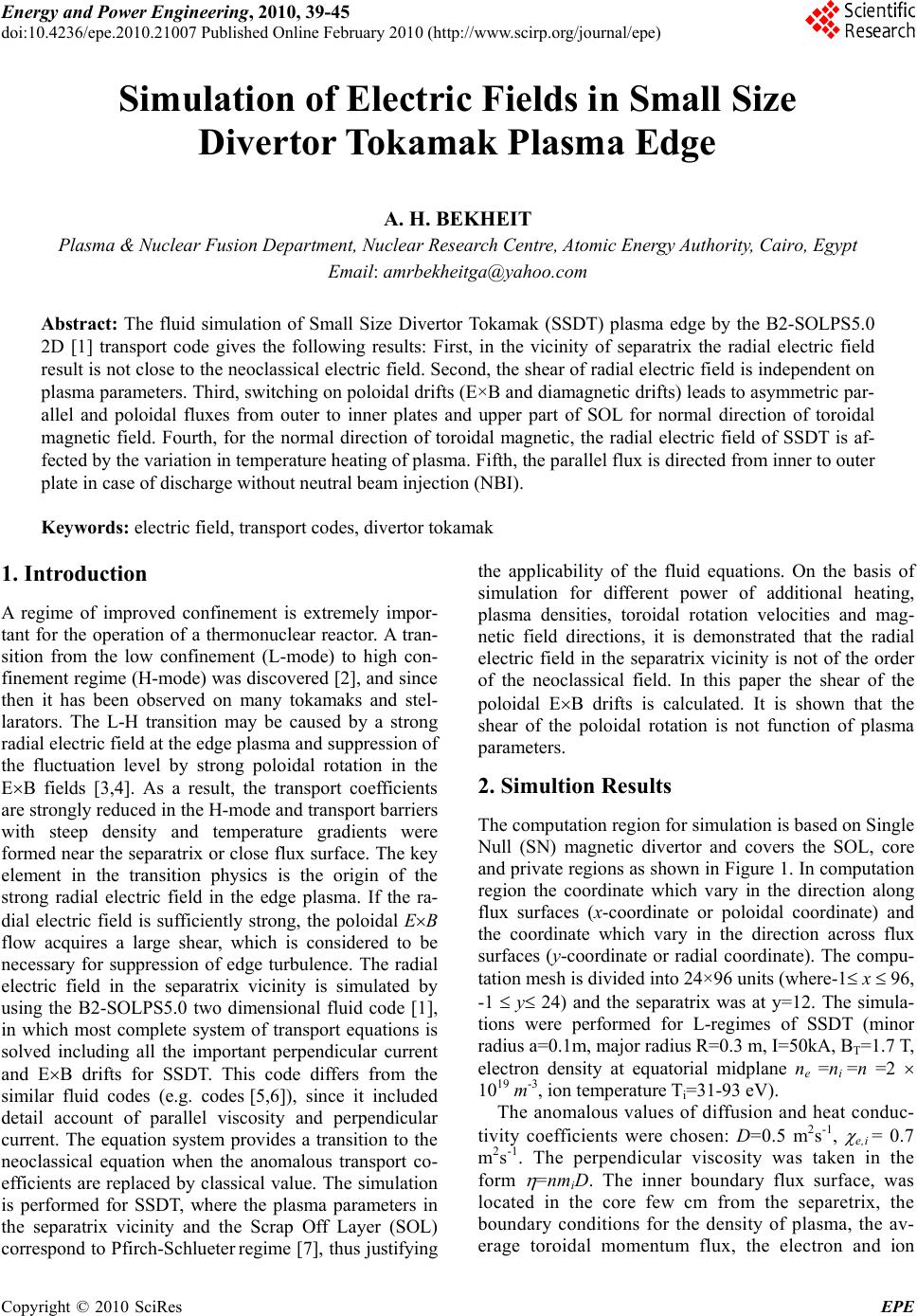 Energy and Power Engineering, 2010, 39-45 doi:10.4236/epe.2010.21007 Published Online February 2010 (http://www.scirp.org/journal/epe) Copyright © 2010 SciRes EPE Simulation of Electric Fields in Small Size Divertor Tokamak Plasma Edge A. H. BEKHEIT Plasma & Nuclear Fusion Department, Nuclear Research Centre, Atomic Energy Authority, Cairo, Egypt Email: amrbekheitga@yahoo.com Abstract: The fluid simulation of Small Size Divertor Tokamak (SSDT) plasma edge by the B2-SOLPS5.0 2D [1] transport code gives the following results: First, in the vicinity of separatrix the radial electric field result is not close to the neoclassical electric f ield. Second, the shear of radial electric f ield is independent on plasma parameters. Third, switching on poloidal dr ifts (E×B and diamagnetic drifts) leads to asymmetric par- allel and poloidal fluxes from outer to inner plates and upper part of SOL for normal direction of toroidal magnetic field. Fourth, for the normal direction of toroidal magnetic, the radial electric field of SSDT is af- fected by the variation in temperature heating of plasma. Fifth, the parallel flux is directed from inner to outer plate in case of discharge without neutral beam injection (NBI). Keywords: electric field, transport codes, divertor tokamak 1. Introduction A regime of improved confinement is extremely impor- tant for the operation of a thermonuclear reactor. A tran- sition from the low confinement (L-mode) to high con- finement regime (H-mode) was discovered [2], and since then it has been observed on many tokamaks and stel- larators. The L-H transition may be caused by a strong radial electric field at the edge plasma and suppression of the fluctuation level by strong poloidal rotation in the EB fields [3,4]. As a result, the transport coefficients are strongly reduced in the H-mode and transport barriers with steep density and temperature gradients were formed near the separatrix or close flux surface. The key element in the transition physics is the origin of the strong radial electric field in the edge plasma. If the ra- dial electric field is sufficiently strong, the poloidal EB flow acquires a large shear, which is considered to be necessary for suppression of edge turbulence. The radial electric field in the separatrix vicinity is simulated by using the B2-SOLPS5.0 two dimensional fluid code [1], in which most complete system of transport equations is solved including all the important perpendicular current and EB drifts for SSDT. This code differs from the similar fluid codes (e.g. codes [5,6]), since it included detail account of parallel viscosity and perpendicular current. The equation system provides a transition to the neoclassical equation when the anomalous transport co- efficients are replaced by classical value. The simulation is performed for SSDT, where the plasma parameters in the separatrix vicinity and the Scrap Off Layer (SOL) correspond to Pfirch-Schlueter regime [7], thus justifying the applicability of the fluid equations. On the basis of simulation for different power of additional heating, plasma densities, toroidal rotation velocities and mag- netic field directions, it is demonstrated that the radial electric field in the separatrix vicinity is not of the order of the neoclassical field. In this paper the shear of the poloidal EB drifts is calculated. It is shown that the shear of the poloidal rotation is not function of plasma parameters. 2. Simultion Results The computation region for simulation is based on Single Null (SN) magnetic divertor and covers the SOL, core and private regions as shown in Figure 1. In computation region the coordinate which vary in the direction along flux surfaces (x-coordinate or poloidal coordinate) and the coordinate which vary in the direction across flux surfaces (y-coordinate or radial coordinate). The compu- tation mesh is divided into 24×96 units (where-1 x 96, -1 y 24) and the separatrix was at y=12. The simula- tions were performed for L-regimes of SSDT (minor radius a=0.1m, major radius R=0.3 m, I=50kA, BT=1.7 T, electron density at equatorial midplane ne =ni =n =2 1019 m-3, ion temperature Ti=31-93 eV). The anomalous values of diffusion and heat conduc- tivity coefficients were chosen: D=0.5 m2s-1, e,i = 0.7 m2s-1. The perpendicular viscosity was taken in the form =nmiD. The inner boundary flux surface, was located in the core few cm from the separetrix, the boundary conditions for the density of plasma, the av- erage toroidal momentum flux, the electron and ion 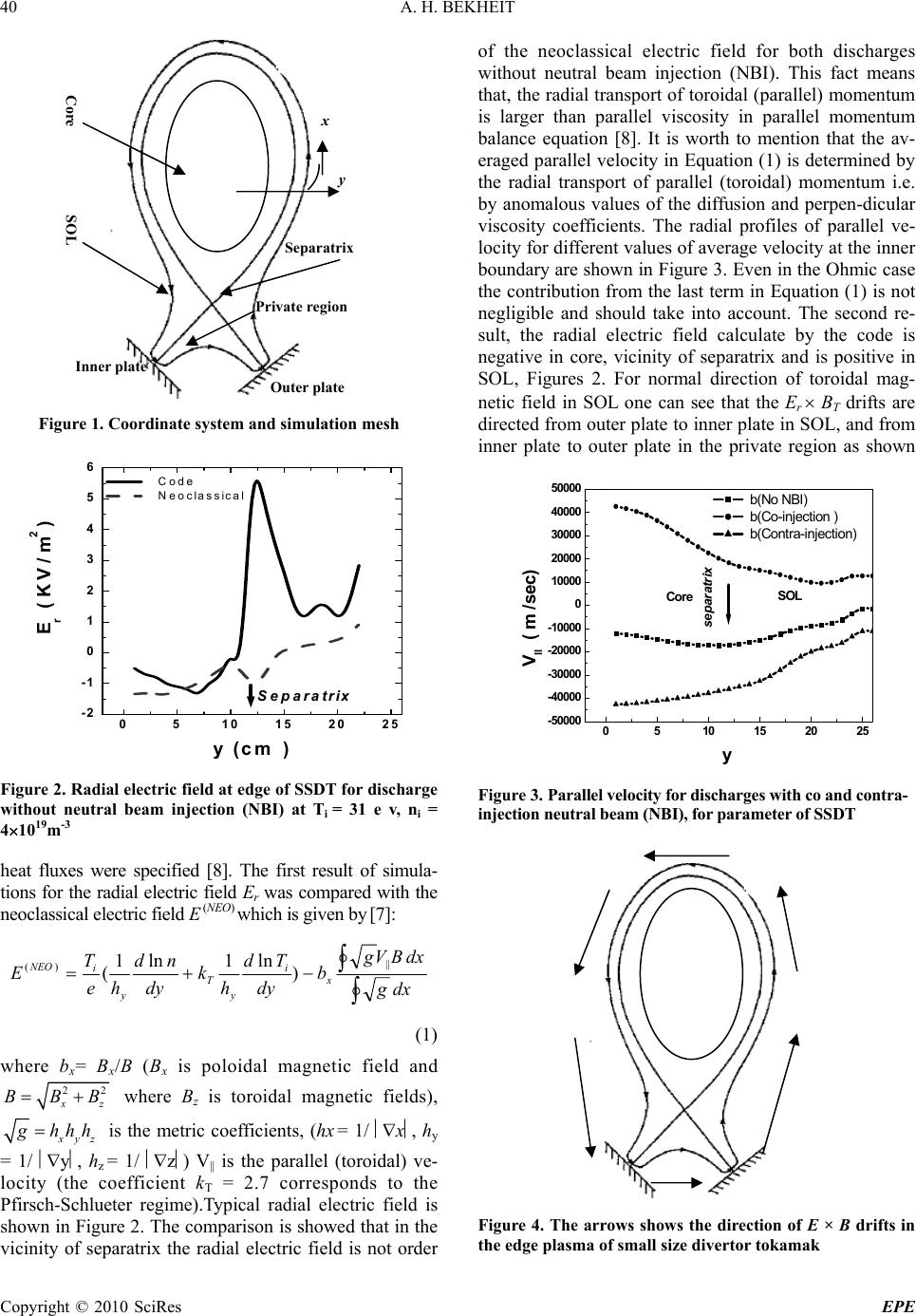 A. H. BEKHEIT Copyright © 2010 SciRes EPE 40 Figure 1. Coordinate system and simulation mesh 0510 15 20 25 -2 -1 0 1 2 3 4 5 6 Separatrix Er ( K V / m2 ) y (cm ) C o de Ne o c la s s ic a l Figure 2. Radial electric field at edge of SSDT for discharge without neutral beam injection (NBI) at Ti = 31 e v, ni = 41019m-3 heat fluxes were specified [8]. The first result of simula- tions for the radial electric field Er was compared with the neoclassic al el ect ric fiel d E (NEO) which is given by [7]: dxg dxBVg b dy Td h k dy nd he T Ex i y T y i NEO || )( ) ln1ln1 ( (1) where bx= Bx/B (Bx is poloidal magnetic field and 22 x z BBB where Bz is toroidal magnetic fields), x yz g hhh is the metric coefficients, (hx = 1/ x, hy = 1/ y, hz = 1/ z) V is the parallel (toroidal) ve- locity (the coefficient kT = 2.7 corresponds to the Pfirsch-Schlueter regime).Typical radial electric field is shown in Figure 2. The comparison is showed that in the vicinity of separatrix the radial electric field is not order of the neoclassical electric field for both discharges without neutral beam injection (NBI). This fact means that, the radial transport of toroidal (parallel) momentu m is larger than parallel viscosity in parallel momentum balance equation [8]. It is worth to mention that the av- eraged parallel velocity in Equation (1) is determined by the radial transport of parallel (toroidal) momentum i.e. by anomalous values of the diffusion and perpen-dicular viscosity coefficients. The radial profiles of parallel ve- locity for different values of averag e velocity at the inn er boundary are shown in Figure 3. Even in the Ohmic case the contribution from the last term in Equation (1) is not negligible and should take into account. The second re- sult, the radial electric field calculate by the code is negative in core, vicinity of separatrix and is positive in SOL, Figures 2. For normal direction of toroidal mag- netic field in SOL one can see that the Er BT drifts are directed from outer plate to inner plate in SOL, and from inner plate to outer plate in the private region as shown 0510 15 20 25 -50000 -40000 -30000 -20000 -10000 0 10000 20000 30000 40000 50000 Core SOL separatrix Vll ( m /sec) y b(N o N BI) b(Co-injection ) b(Contra-injection) Figure 3. Parallel velocity for discharges with co and contra- injection neutral beam (NBI), for parameter of SSDT Figure 4. The arrows shows the direction of E × B drifts in the edge plasma of small size divertor tokamak Inner plate SOL Core Outer plate Private re gio n Separatrix x y 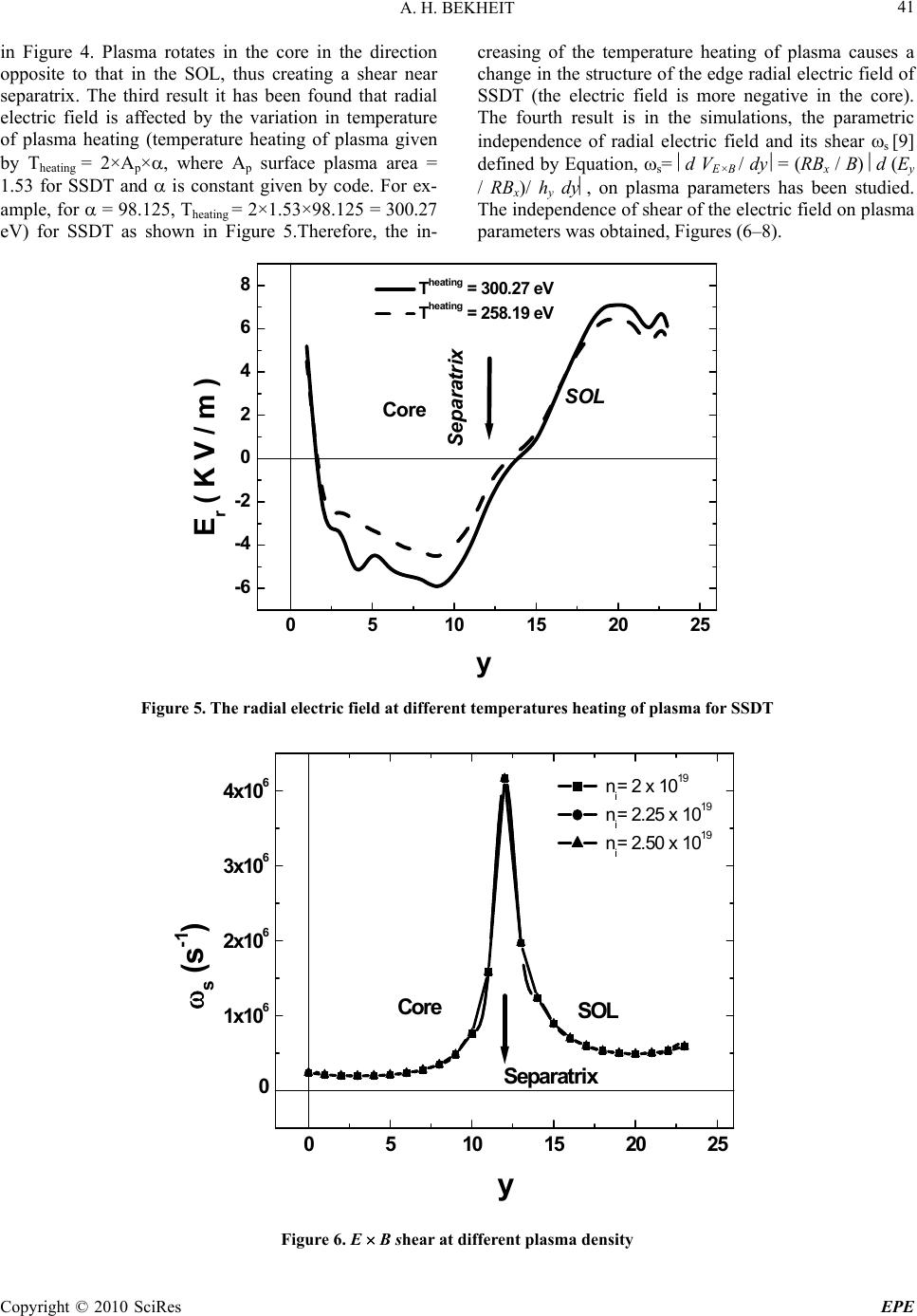 A. H. BEKHEIT Copyright © 2010 SciRes EPE 41 in Figure 4. Plasma rotates in the core in the direction opposite to that in the SOL, thus creating a shear near separatrix. The third result it has been found that radial electric field is affected by the variation in temperature of plasma heating (temperature heating of plasma given by Theating = 2×Ap×, where Ap surface plasma area = 1.53 for SSDT and is constant given by code. For ex- ample, for = 98.1 25, Theating = 2×1.53×98.125 = 300.27 eV) for SSDT as shown in Figure 5.Therefore, the in- creasing of the temperature heating of plasma causes a change in the structure of the edge radial electric field of SSDT (the electric field is more negative in the core). The fourth result is in the simulations, the parametric independence of radial electric field and its shear s [9] defined by Equation, s= d VE×B / dy = (RBx / B) d (Ey / RBx)/ hy dy, on plasma parameters has been studied. The independence of shear of the electric field on plasma parameters was obtained, Figures (6–8). 0510 1520 25 -6 -4 -2 0 2 4 6 8 Core SOL Separatrix Er ( K V / m ) y Theat ing = 300.27 eV Theat ing = 258.19 eV Figure 5. The radial electric field at different temperatures heating of plasma for SSDT 0510 15 20 25 0 1x106 2x106 3x106 4x106 Core SOL Separatrix s (s-1) y ni= 2 x 1019 ni= 2.25 x 1019 ni= 2.50 x 1019 Figure 6. E B shear at different plasma density 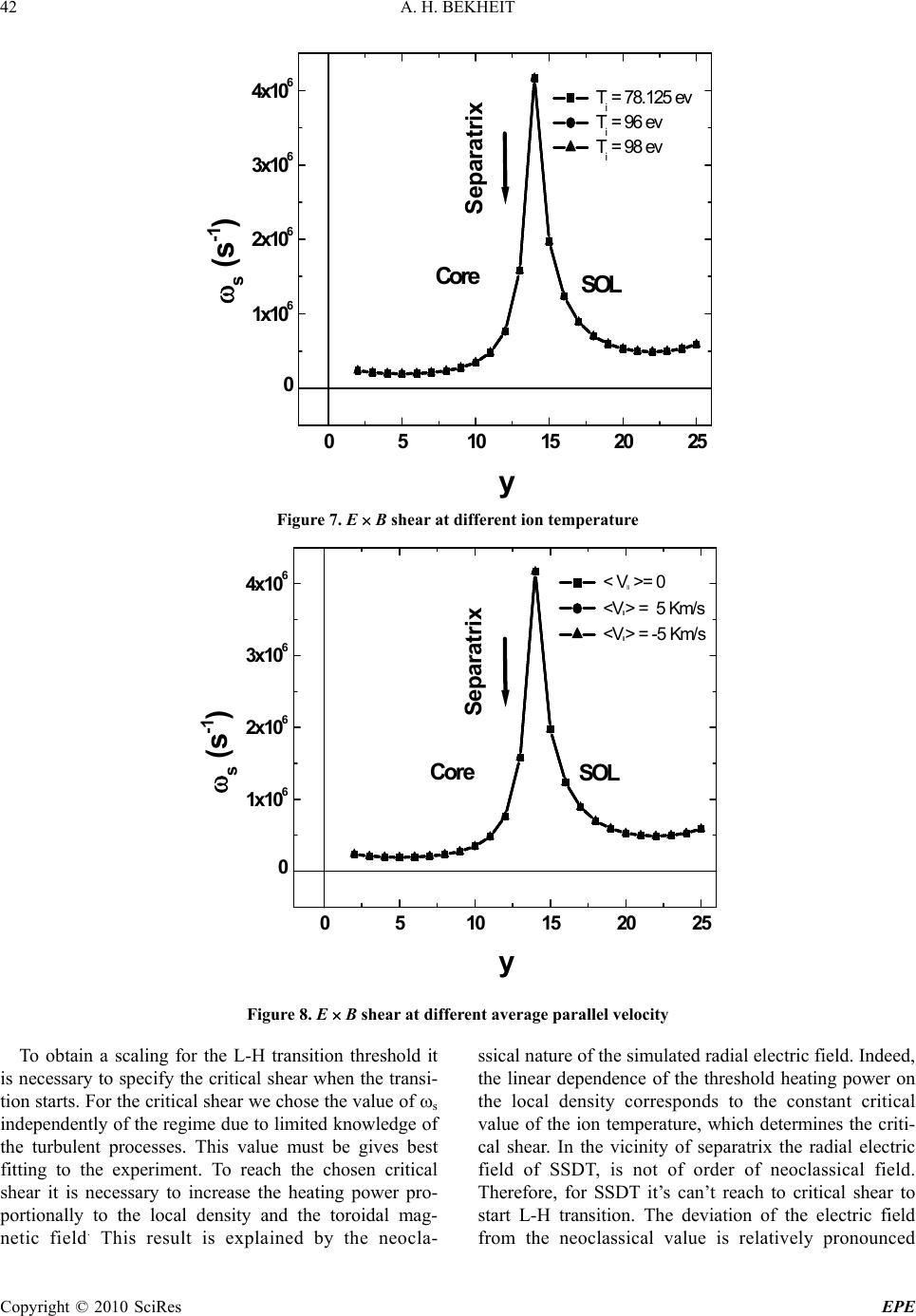 A. H. BEKHEIT Copyright © 2010 SciRes EPE 42 0510 15 20 25 0 1x106 2x106 3x106 4x106 CoreSOL Separat rix s (s -1) y T i = 78.125 ev T i = 96 ev T i = 98 ev Figure 7. E B shear at different ion temperature 051015 20 25 0 1x106 2x106 3x106 4x106 CoreSOL Sep ara trix s (s-1) y < V ll >= 0 < V ll> = 5 K m/s < V ll> = -5 K m/s Figure 8. E B shear at different average parallel velocity To obtain a scaling for the L-H transition threshold it is necessary to specify the critical shear when the transi- tion starts. For the critical shear we chose the value of s independently of the regime due to limited knowledge of the turbulent processes. This value must be gives best fitting to the experiment. To reach the chosen critical shear it is necessary to increase the heating power pro- portionally to the local density and the toroidal mag- netic field. This result is explained by the neocla- ssical nature of the simulated radial electric field. Indeed, the linear dependence of the threshold heating power on the local density corresponds to the constant critical value of the ion temperature, which determines the criti- cal shear. In the vicinity of separatrix the radial electric field of SSDT, is not of order of neoclassical field. Therefore, for SSDT it’s can’t reach to critical shear to start L-H transition. The deviation of the electric field from the neoclassical value is relatively pronounced 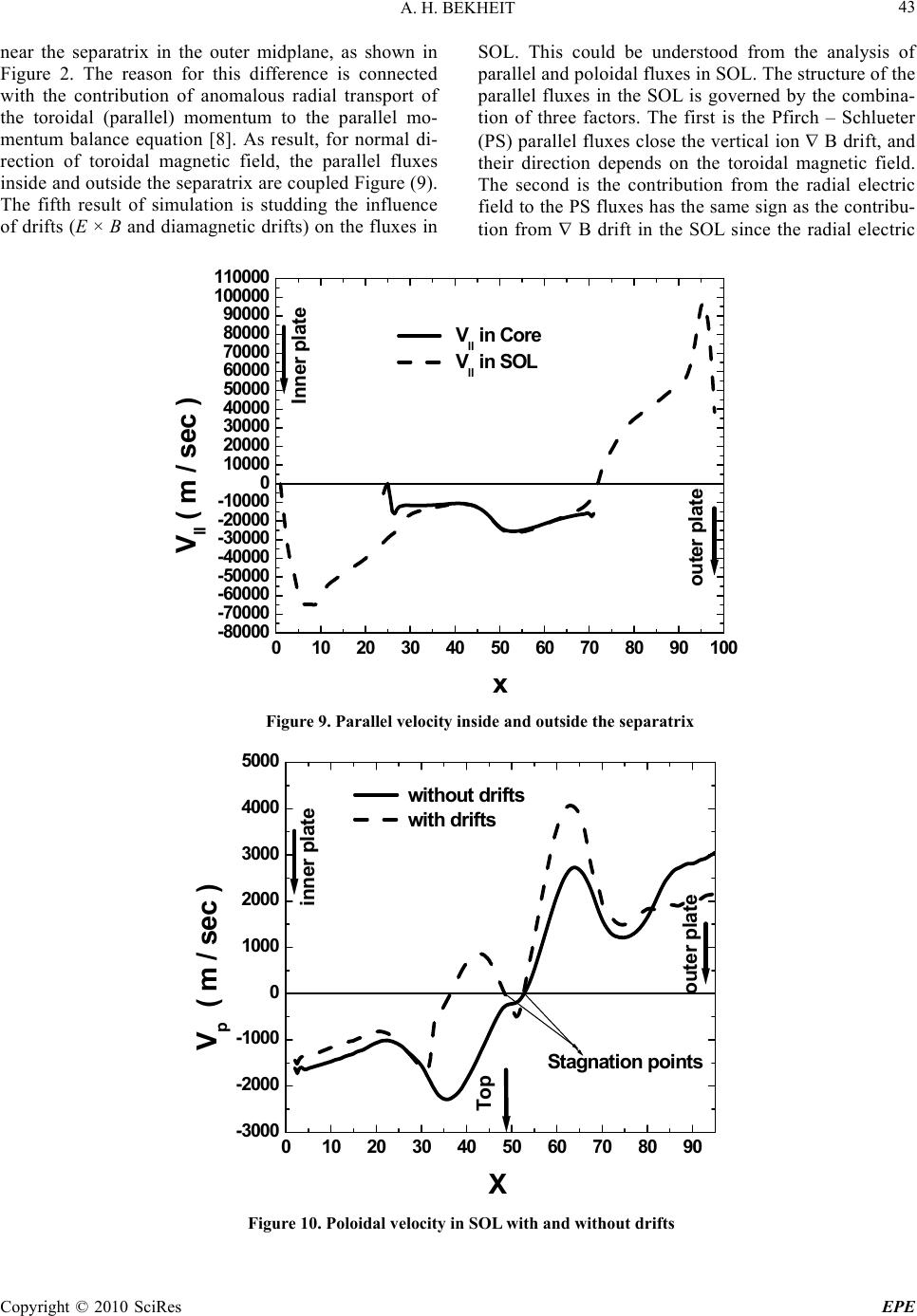 A. H. BEKHEIT Copyright © 2010 SciRes EPE 43 near the separatrix in the outer midplane, as shown in Figure 2. The reason for this difference is connected with the contribution of anomalous radial transport of the toroidal (parallel) momentum to the parallel mo- mentum balance equation [8]. As result, for normal di- rection of toroidal magnetic field, the parallel fluxes inside and outside the separatrix are coupled Figure (9). The fifth result of simulation is studding the influence of drifts (E × B and diamagnetic drifts) on the fluxes in SOL. This could be understood from the analysis of parallel and poloidal fluxes in SOL. The structure of the parallel fluxes in the SOL is governed by the combina- tion of three factors. The first is the Pfirch – Schlueter (PS) parallel fluxes close the vertical ion B dr ift, and their direction depends on the toroidal magnetic field. The second is the contribution from the radial electric field to the PS fluxes has the same sign as the contribu- tion from B drift in the SOL since the radial electric 0 102030405060708090100 -80000 -70000 -60000 -50000 -40000 -30000 -20000 -10000 0 10000 20000 30000 40000 50000 60000 70000 80000 90000 100000 110000 outer p late Inner plate Vll ( m / sec ) x Vll in Co r e Vll in SOL Figure 9. Parallel velocity inside and outside the separatrix 0 102030405060708090 -3000 -2000 -1000 0 1000 2000 3000 4000 5000 Stagnation points Top outer plate inner plate Vp ( m / se c ) X without drifts w ith d rift s Figure 10. Poloidal velocity in SOL with and without drifts  A. H. BEKHEIT Copyright © 2010 SciRes EPE 44 0 102030405060708090100 -160000 -140000 -120000 -100000 -80000 -60000 -40000 -20000 0 20000 40000 60000 80000 100000 120000 140000 160000 Top stagnation point stagnation point outer plate inner plate Vll ( m / sec ) x w ith d r ifts w ith o u t d r ifts Figure 11. Parallel velocity with and without drifts 051015 2025 -20000 -18000 -16000 -14000 -12000 -10000 -8000 -6000 -4000 -2000 Core SOL Separatrix Vll ( m / sec ) y ( cm ) Figure 12. Parallel flux in the edge of SSDT field is positive in the SOL as shown in Figure 2 (inside separatrix, where the radial electric field is negative, the contribution to PS fluxes B drifts and EB drift compensate each other in accordance with neoclassical theory). The third contribution arises from the poloidal fluxes that are responsible for the particle transport to the plates. Those poloidal fluxes are closed the radial diffu- sive particle fluxes. In the absence of the poloidal EB and B drifts these fluxes coincide with the projection of the parallel fluxes. On the one hand, the outer plate is larger than the inner plate and the integral poloidal flux to this plate should be larger. On the other hand, since the plasma in the vicinity of the inner plate is colder and denser, the particle flux per square meter to this plate that is proportional to n (T/mi)1/2 is larger than particle flux to outer plate (the pressure is almost the same at the plates). Switching on EB drift leads to asymmetric in parallel and poloidal fluxes from outer to inner plates and upper part of SOL as shown as in Fig ures (10,11). Also switch- ing on the poloidal dr ifts leads to decrease of the parallel velocity, because the poloidal projection of the parallel velocity not compensates poloid al EB drifts, so that the poloidal rotation changes. Moreover, the position stagna- tion point for the poloidal did not change much which is  A. H. BEKHEIT Copyright © 2010 SciRes EPE 45 located somewhere near the upper part of the SOL, as shown in Figure 11. In contrast, the position of the stag- nation point for parallel flux may be significantly differ- ent Figure 11. For normal B the stagnation point is strongly shifted toward s the outer plate. This fact is con- sistent with the observations with simulations [10]. Fi- nally the parallel flow pattern is the result of all three factors. For normal B parallel flux in SOL is negative as sh own in Fig ure 12. Therefo re, for normal B parallel flux is directed from outer to inner plate. 3. Conclusions In conclusion, the performed simulations for SSDT demonstrate the following results: (First) In the vicinity of separatrix the radial electric field was not close to the neoclassical electric field. (Second) the independence of the shear of radial electric field on plasma parameters. (Third) For normal direction of torodial magnetic field, the radial electric field of SSDT was affected by the variation in temperature heating of plasma. (Fourth) Switching on poloidal d rifts leads to asymmetric parallel and poloidal fluxes from outer to inner plates and upper part of SOL for normal direction of toroidal magnetic field. Also switching on the poloidal drifts leads to de- crease of the parallel velocity, because the poloidal pro- jection of the parallel velocity not compensates poloidal EB drifts, so that the poloidal rotation changes. (Fifth) The parallel flux is directed from outer to inner plate. (Sixth) The E×B drift are directed from outer plate to inner plate in SOL, and from inner plate to outer plate in the private region. REFERENCES [1] R. Schneider, V. Rozhansky, and P. Xantopoulos, Contri- bution Plasma Physics, No. 40, pp. 4213, 2004. [2] F. Wagner, Physical Review Letters, No. 49, pp. 1408, 1982. [3] H. Biglari, P. H. Diamond, and P. W. Terry, Physics of Fluids, No. B21, pp. 1, 1990. [4] K. H. Burrell, Physics of Plasma, No. 4, pp. 1499, 1997. [5] G. J. Radford, Contribution Plasma Physics, No. 36, pp. 187, 1996. [6] T. D. Rognlien, D. D. Ryutov, N. Mattor, and G. D. Porter, Physics of Plasmas, No. 6, pp. 1851, 1999. [7] S. P. Hirshman and D. J. Sigmar, Nuclear Fusion, No. 21, pp. 1079, 1981. [8] A. H. Bekheit, Egyptian Journal of Fusion energy, Vol. 28, No. 4, pp. 338–345, 2008. [9] T. S. Hahm and K. H. Burrell, Phyics of Plasma, No. 2, pp. 1648, 1994. [10] S. K. Erents, G. Corrigan, and J. Spence, Journal of Nu- clear Materials, No. 290–293, pp. 518, 2001. |

